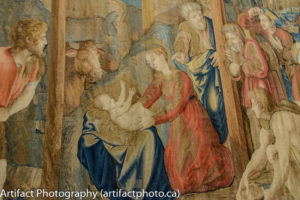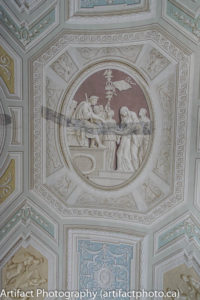Have you ever gone into a museum with a lot of restrictions and a lot of valuable artifacts, as a tourist? You want a few representative images for your vacation album or a memory for your wall, you want to do a good job of it, but the constraints are pretty severe? Here’s how I tackled the Vatican Museum.
The Vatican Museum
The Vatican City has been a sovereign state since 1929. Consisting of about 100 acres located in Rome, Italy, it has less than 1,000 permanent inhabitants, including the Pope, priests, security staff, and support staff. It consists mainly of St. Peter’s Basilica, St. Peter’s Square, extensive gardens, and the Papal complex, including the Vatican Museum.
The museums started as a group of sculptures collected by Pope Julius II (1503-1513). There are now 11 museums interconnected in one complex, varying from historical museums (Etruscan Museum, Egyptian Museum, Hebrew Lapidary) to art museums (Gallery of Tapestries, Gallery of Maps, specialty museums (The Carriage and Automobile Museum), and of course, the Sistine Chapel.
For more information about the Vatican Museums, check out their website.

Sculpture Galleries
The sculpture on display is a vast and beautiful collection housed in a number of halls in the northern galleries of the Museums. While not strictly a “no-flash” area, my on-camera flash was not up to the task and I didn’t bring an off-camera flash to pretty it up with.

This left me with the museum gallery lighting. This was, in some rooms quite dim, and rather than increasing the ISO settings and encouraging grain in the dark areas, I elected to go with long exposures.
This is difficult to do with no tripod, so I looked for surfaces I could rest the camera on, such as tables, rails, and plinths. More often than not, I found myself hand-holding a longish exposure by pressing the camera into a convenient pillar or wall. In these cases, the exposures were not longer than half a second. Even so, I had to raise my ISO to 640.

Although the sculpture was the object in these galleries, the rooms themselves were quite beautiful with mosaic floors and artist painted ceilings, marble walls and sculpted plaster. White balance required the frequent use of my trusty grey card, as the lighting in each room was different. On a number of occasions a helpful security guard would see what I was doing and switch on a floor lamp to help with the exposure. Lying down on the floor to get a solid shot was not welcome, so I increased my ISO to 1000 and steadied the camera on a railing to get the above shot at 0.8 sec.
The Tapestry Gallery

By necessity, the Tapestry Gallery was fairly dark, compensated by a light coloured ceiling. Flash was not allowed. To get decent shots in here, I had to go handheld and increased my ISO to 4000. Even so, I had to steady the camera on a stanchion for this 1/3 sec shot.

The ceilings in here were painted to look like carved plaster. The stabilized repair of the crack shows that it is not. Plaster throughout the museum was damaged in the earthquake that occurred on August 24, 2016.
Unfortunately, the skills to repair this kind of painting are rare and the tape job will have to suffice until a qualified restoration artist can be found. This is one of the many costs of running a museum full of “priceless” art and artifacts. You can’t sell the stuff for anywhere near its worth, but it needs temperature and humidity controls and must constantly be monitored for degradation.
The Map Gallery

The first thing you notice when you enter the map gallery is not the maps. The ceiling is spectacular. Dozens of individual paintings adorn the plaster above you in this recently restored long gallery.
Luckily, this ceiling is more brightly lit than others, so I was able to handhold my shots at ISO 4000, at 1/15 sec.
The maps show areas of Italy and its islands, including mountain ranges and water courses. Some maps have insert maps of specific towns and locales.

The Sistine Chapel
There is no photography of any kind allowed in the Sistine Chapel. No flash, no video, no natural light. I’m not entirely sure why no natural light photography, but it’s a rule. We should follow and respect it. It may be that they would prefer you to buy their book from the gift shop. If so, and you want pictures of the ceiling and walls, why not support them and buy one? It costs a fortune to maintain these galleries and they let you photograph everything else in the place. Why be a jerk and ignore their rules? If you’re doing a book or something and need original photographs, you’re likely going to need a property release anyway, and they can probably arrange for you to have alone time with the room to take them. Probably it will cost you money. So be it.
We observed people wandering in, ignoring the requests (given in multiple languages, repeatedly) to not shoot. They’d get all flustered when the Vatican Police would kindly remind them it isn’t an option. We saw one guy in a wheelchair rolling along with his iPad in his lap, scanning the ceiling. Crazy! Buy the book. The images will be better, done by professionals in much better perspective and lighting than you can achieve in a room full of tourists. Support the museum. You came all this way, spent all that money just to take inferior photographs. Buy the book!
Finally

The Vatican Museums are well worth the visit. If I was in Rome for a month, I’d probably go there at least ten times. There is so much to see and revisit. And I’m not even Roman Catholic.
Again, for more information about the Vatican Museums, check out their website. We did the evening dinner tour, where we ate a meal in the courtyard and got into the museum a half hour before the general public. Definitely worthwhile.
This blog is published every Monday at 9:00 am, Eastern Standard Time. If you have comments, questions, or can think of a better approach, feel free to leave a comment. I’ll try to get back to you with a pithy answer.
Feel free to explore the rest of the Artifact Photography (a division of 1350286 Ontario Inc.) website at www.artifactphoto.ca.
